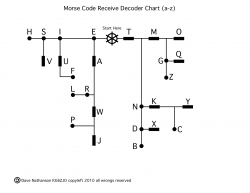

#PIC BASIC MORSE DECODER PRO#

If you struggle with basic communication, barely anyone will provide you with the necessary information or rich enough data. Then you can hone the details by practicing in the every day world of an adult. Using similarities, key concepts, and basic differences, then using that theoretical model to teach yourself an intuitive model. The amount of necessary data and correlations is just not there, the information is way too “high-level” and specific to learn just by “sink-or-swim”.Īn adult learns much better by “compressed learning” or difference learning. People are also less helpful or patient when asking for unknown words or explanations. What people forget is that adults do not get exposed to the same basic level of interactions that kids do. Posted in Machine Learning Tagged cnn, CTC, cw, lstm, machine learning, morse, SNR, tensorflow Post navigation We find that fascinating, and wonder what other applications this would be good for.
#PIC BASIC MORSE DECODER CODE#
By comparing patterns to labels in the training data, it inferred what the characters mean, and essentially taught itself Morse code in about an hour. Other Morse decoders use lookup tables to convert sound to text, but it’s important to note that this one doesn’t. The model was also able to pull Morse out of a signal with -6 dB signal-to-noise ratio, even though it had been trained with a much cleaner signal. The first training run only resulted in about 36% accuracy, but a subsequent run with shorter snippets ended up being 99.5% accurate. Using a few lines of Python, he converts short, known snippets of Morse to a grayscale image that looks a little like a barcode, with the light areas being the dits and dahs and the dark bars being silence. But things take an unexpected turn right from the start, as uses a Tensorflow handwriting recognition implementation to train his model.

His method uses curated training data to build a model, namely Morse snippets and their translations, as is the usual approach with such systems. The blog entry by the delightfully callsigned reads like a scientific paper, with good reason: really seems to know a thing or two about machine learning. Militaries use immersion language instruction, as do diplomats and journalists, and apparently computers can now use it to teach themselves Morse code. Conventional wisdom holds that the best way to learn a new language is immersion: just throw someone into a situation where they have no choice, and they’ll learn by context.


 0 kommentar(er)
0 kommentar(er)
